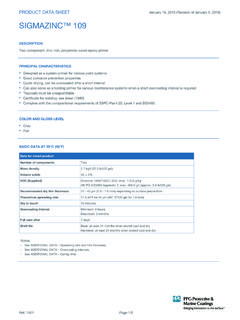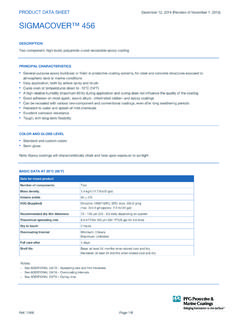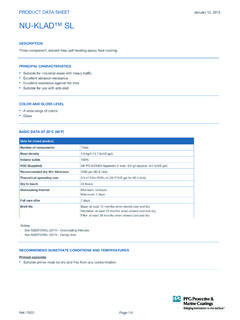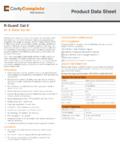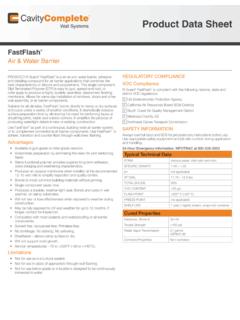Transcription of Material Safety Data Sheet - New Guard Coatings
1 Material Safety data Sheet Penguard Topcoat AV Comp B. 1. Product and company identification Trade name : Penguard Topcoat AV Comp B. Material uses : Coatings : Hardener / Solvent-borne. Manufacturer : Jotun Paints, Inc. 9203 Highway 23. Belle Chasse, LA 70037. Telephone: (800) 229-3538 or (504) 394-3538. In case of emergency : 1-800-424-9300. 1,2 1170. VValidationDate). 1. 2. Hazards identification Physical state : Liquid. Odor : Characteristic. OSHA/HCS status : This Material is considered hazardous by the OSHA Hazard Communication Standard (29 CFR ). CAUTION! COMBUSTIBLE LIQUID AND VAPOR. Combustible liquid. Keep away from heat, sparks and flame. Avoid breathing vapor or mist. Avoid contact with skin and clothing. Use only with adequate ventilation. Eyes : May cause eye irritation. Skin : May cause skin irritation.
2 Inhalation : Exposure to decomposition products may cause a health hazard. Serious effects may be delayed following exposure. Ingestion : No known significant effects or critical hazards. Potential chronic health : CARCINOGENIC EFFECTS: Not available. effects MUTAGENIC EFFECTS: Not available. TERATOGENIC EFFECTS: Not available. Medical conditions : None known. aggravated by over- exposure See toxicological information (Section 11). 3. Composition/information on ingredients Name CAS number % by weight Solvent naphtha (petroleum), light aromatic 64742-95-6 25 - 50. Components not listed are not physical or health hazards as defined in 29 CFR (Hazard Communication Standard). Continued on next page Penguard Topcoat AV Comp B Page: 2/7. 4. First aid measures Eye contact : Check for and remove any contact lenses.
3 Immediately flush eyes with plenty of water for at least 15 minutes, occasionally lifting the upper and lower eyelids. Get medical attention immediately. Skin contact : In case of contact, immediately flush skin with plenty of water for at least 15 minutes while removing contaminated clothing and shoes. Wash clothing before reuse. Clean shoes thoroughly before reuse. Get medical attention immediately. Inhalation : Move exposed person to fresh air. If not breathing, if breathing is irregular or if respiratory arrest occurs, provide artificial respiration or oxygen by trained personnel. Loosen tight clothing such as a collar, tie, belt or waistband. Get medical attention immediately. Ingestion : Wash out mouth with water. Do not induce vomiting unless directed to do so by medical personnel.
4 Never give anything by mouth to an unconscious person. Get medical attention immediately. Protection of first-aiders : No action shall be taken involving any personal risk or without suitable training. It may be dangerous to the person providing aid to give mouth-to-mouth resuscitation. 5. Fire-fighting measures Flammability of the product : Combustible Products of combustion : Decomposition products may include the following materials: carbon dioxide carbon monoxide nitrogen oxides Suitable : Use dry chemical, CO , water spray (fog) or foam. Not suitable : Do not use water jet. Special exposure hazards : Promptly isolate the scene by removing all persons from the vicinity of the incident if there is a fire. No action shall be taken involving any personal risk or without suitable training.
5 Move containers from fire area if this can be done without risk. Use water spray to keep fire-exposed containers cool. Fire water contaminated with this Material must be contained and prevented from being discharged to any waterway, sewer or drain. Combustible liquid. In a fire or if heated, a pressure increase will occur and the container may burst, with the risk of a subsequent explosion. Special protective : Fire-fighters should wear appropriate protective equipment and self-contained breathing equipment for fire-fighters apparatus (SCBA) with a full face-piece operated in positive pressure mode. 6. Accidental release measures Personal precautions : No action shall be taken involving any personal risk or without suitable training. Evacuate surrounding areas. Keep unnecessary and unprotected personnel from entering.
6 Do not touch or walk through spilled Material . Shut off all ignition sources. No flares, smoking or flames in hazard area. Avoid breathing vapor or mist. Provide adequate ventilation. Wear appropriate respirator when ventilation is inadequate. Put on appropriate personal protective equipment (see Section 8). Environmental precautions : Avoid dispersal of spilled Material and runoff and contact with soil, waterways, drains and sewers. Inform the relevant authorities if the product has caused environmental pollution (sewers, waterways, soil or air). Water polluting Material . May be harmful to the environment if released in large quantities. Methods for cleaning up : Stop leak if without risk. Move containers from spill area. Use spark-proof tools and explosion-proof equipment. Approach release from upwind.
7 Prevent entry into sewers, water courses, basements or confined areas. Wash spillages into an effluent treatment plant or proceed as follows. Contain and collect spillage with non- combustible, absorbent Material sand, earth, vermiculite or diatomaceous earth and place in container for disposal according to local regulations (see Section 13). Dispose of via a licensed waste disposal contractor. Contaminated absorbent Material may pose the same hazard as the spilled product. Note: see Section 1 for emergency contact information and Section 13 for waste disposal. Continued on next page Penguard Topcoat AV Comp B Page: 3/7. 6. Accidental release measures 7. Handling and storage Handling : Put on appropriate personal protective equipment (see Section 8). Eating, drinking and smoking should be prohibited in areas where this Material is handled, stored and processed.
8 Workers should wash hands and face before eating, drinking and smoking. Remove contaminated clothing and protective equipment before entering eating areas. Do not ingest. Avoid contact with eyes, skin and clothing. Avoid breathing vapor or mist. Avoid release to the environment. Use only with adequate ventilation. Wear appropriate respirator when ventilation is inadequate. Do not enter storage areas and confined spaces unless adequately ventilated. Keep in the original container or an approved alternative made from a compatible Material , kept tightly closed when not in use. Store and use away from heat, sparks, open flame or any other ignition source. Use explosion-proof electrical (ventilating, lighting and Material handling) equipment. Use non-sparking tools. Take precautionary measures against electrostatic discharges.
9 To avoid fire or explosion, dissipate static electricity during transfer by grounding and bonding containers and equipment before transferring Material . Empty containers retain product residue and can be hazardous. Do not reuse container. Storage : Store in accordance with local regulations. Store in a segregated and approved area. Store in original container protected from direct sunlight in a dry, cool and well- ventilated area, away from incompatible materials (see Section 10) and food and drink. Eliminate all ignition sources. Separate from oxidizing materials. Keep container tightly closed and sealed until ready for use. Containers that have been opened must be carefully resealed and kept upright to prevent leakage. Do not store in unlabeled containers. Use appropriate containment to avoid environmental contamination.
10 8. Exposure controls/personal protection Product name Exposure limits Solvent naphtha (petroleum), light aromatic NIOSH REL (United States, 6/2001). TWA: 125 mg/m 10 hours. Form: All forms TWA: 25 ppm 10 hours. Form: All forms ACGIH TLV (United States, 1/2005). TWA: 123 mg/m 8 hours. Form: All forms TWA: 25 ppm 8 hours. Form: All forms OSHA PEL 1989 (United States, 3/1989). TWA: 125 mg/m 8 hours. Form: All forms TWA: 25 ppm 8 hours. Form: All forms Engineering measures : Use only with adequate ventilation. Use process enclosures, local exhaust ventilation or other engineering controls to keep worker exposure to airborne contaminants below any recommended or statutory limits. The engineering controls also need to keep gas, vapor or dust concentrations below any lower explosive limits. Use explosion-proof ventilation equipment.

